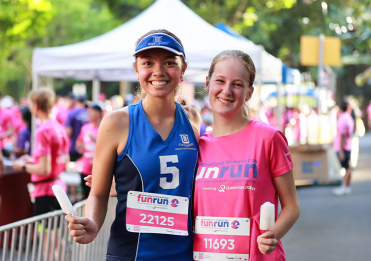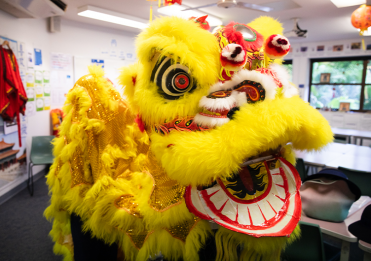The oldest pocket held by the School archives is Noela Hardy’s (1930) ‘Blue’. The pocket, dated 1929-30, was awarded to Noela for her prowess in tennis, a sport she captained in 1930.
Originally, a Grammar girl’s blazer had three blank pockets and it was up to the student to succeed in the sporting arena to embellish her top pocket, often embroidered by hand.

Noela Hardy’s hand-embroidered blazer pocket

1930 The A Tennis team—Noela Hardy, Captain (seated)
The needlework may be a little wonky, but the effort and love imbued in every stitch are apparent. Modern Blues may look more professional, but it is doubtful they are any more treasured than this one was and is.
The concept of awarding sporting colours or pockets originated in the English universities of Oxford and Cambridge. Outstanding sportsmen were eligible for a blazer in the university colours, and thus these sporting awards were called ‘Blues’ because of the colours of those two famous universities.
Mr Reginald Roe, Brisbane Grammar School Principal (1876-1909), adopted these Oxford/Cambridge colours and the concept of their sporting awards for BGS. This is possibly why the term ‘Blue’ became universal for the highest pocket within both Brisbane Grammar communities. As a graduate of Cambridge University herself, and a founding member of the QGSSSA in 1908, Lady Principal, Miss Milisent Wilkinson (1900-1912), would have endorsed pockets and formal school sporting competitions.
The first tangible evidence of Girls Grammar pockets is a 1916 photograph of the winners of the Secondary Schools Cup and commentary of ‘Blue’ winners in individual sports reports in the 1916 Magazine. Joan Lilley (1917) and Eleanor Hart (1919) are photographed wearing their blazers with embroidered pockets, the earliest dated 1914.

1916 Secondary Schools Association Cup winners
The ‘Blue’ was the embroidering of the School badge onto the top left pocket, with BGGS above and the specific details of the sport below. These specific sports were recorded as ‘1st 7 1916’. Further sports pockets were added below the first row of embroidery and even onto the lower left-hand pocket of the blazer. A half blue was the embroidering of BGGS and the sports specific detail, leaving a gap for the School badge if awarded a full blue at a later stage.

1934 Athletics ‘half blue’
In 1964, the embroidered School badge became a permanent addition to the blazer and, therefore, the concept of the Blue had to change. The result of this change was that the ‘Blue’ was represented by gold tacking around the crest on the pocket with the sport and date in gold thread under the badge.

1963 Elizabeth Hatton’s ‘Blue’
Criteria for pockets, in general, changed across the next two decades. In 1979, the criteria for a ‘Blue’ shifted to State representation and two years’ service in A Grade (now defined as the ‘Open’ competition), making this pocket more prestigious and decidedly more difficult to achieve.
In 1985, as Director of Health, Physical Education and Sport, I submitted a proposal to make the ‘Blue’ a separate pocket on the top right-hand side of the blazer. The design was to reflect the original ‘Blue’ with BGGS in royal blue script with the embroidering of the sport and date below. I did this for three reasons: the Blue was the most difficult and prestigious pocket a Grammar girl could receive and warranted a more substantial display; it presented an opportunity to honour the Blue’s original design, and I had always admired the BGS elegant and elaborate blazer with the balanced design of two top pockets. Principal, Mrs Judith Hancock, approved the concept and the design.
In 2016, as Dean of School at the time, Principal, Ms Jacinda Euler, asked me to submit a proposal for the awarding of academic pockets. The submission reflected the co-curricular awards system with pockets to be awarded being the Blue, a full pocket, a half pocket, and a general pocket. The new academic ‘Blue’ is now awarded to the Dux of the School (Year 12) as the Lady Lilley Gold medallist and the dux in Year 11 as the Annie Mackay Bursary recipient. The first in this category of Blues were awarded at Speech Day in 2016.
Is this nineteenth-century concept an anachronism? Just how important is the ‘Blue’ in the twenty-first century? Does it still carry significant meaning for the Grammar girl?
Matina Samios, Lady Lilley Gold medallist 2020, states: ‘Receiving my Year 11 Annie Mackay Bursary Blue, and being compared to the likes of state and national representatives, was a huge honour, and I was so thrilled to have it embroidered on my blazer. In particular, I appreciated the acknowledgement of the time and effort I dedicated to my studies…’ (Email 15.09.21)
Sarah Morton (2011) reflects, ‘At the time, I was just so excited to be recognised for my achievement in the sport that I love. On reflection, that Blue is even more meaningful…’ For Sarah, the Blue provided motivation to continue at the highest level with both her studies and sport.
Hand-embroidered or professionally machined, the Blue is part of our culture and attests to the dedication, talent, and accolades these Grammar girls deserve.
Ms Pauline Harvey-Short (1971)
Manager, School History and Culture

2011 Sarah Morton’s Blue

1917 Sports Teams - note the full and half blues




